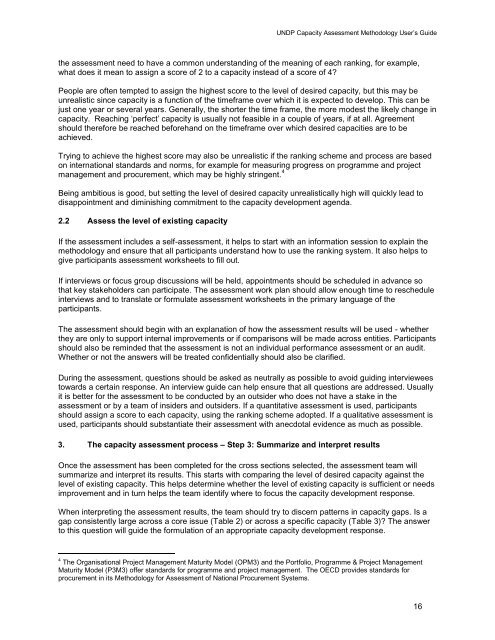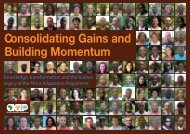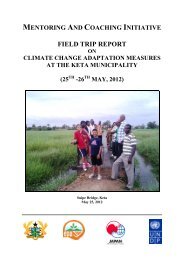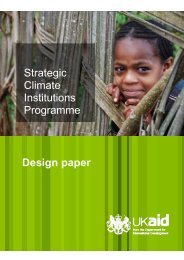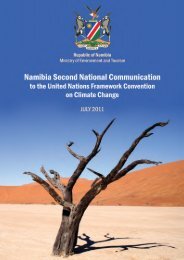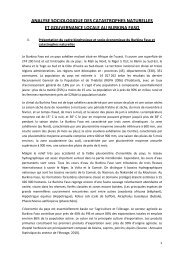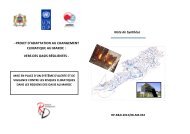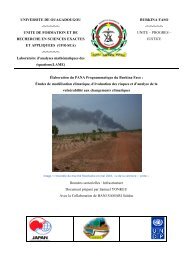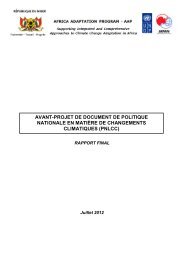UNDP Capacity Assessment Users Guide.pdf - Africa Adaptation ...
UNDP Capacity Assessment Users Guide.pdf - Africa Adaptation ...
UNDP Capacity Assessment Users Guide.pdf - Africa Adaptation ...
Create successful ePaper yourself
Turn your PDF publications into a flip-book with our unique Google optimized e-Paper software.
<strong>UNDP</strong> <strong>Capacity</strong> <strong>Assessment</strong> Methodology User‘s <strong>Guide</strong>the assessment need to have a common understanding of the meaning of each ranking, for example,what does it mean to assign a score of 2 to a capacity instead of a score of 4?People are often tempted to assign the highest score to the level of desired capacity, but this may beunrealistic since capacity is a function of the timeframe over which it is expected to develop. This can bejust one year or several years. Generally, the shorter the time frame, the more modest the likely change incapacity. Reaching ‗perfect‘ capacity is usually not feasible in a couple of years, if at all. Agreementshould therefore be reached beforehand on the timeframe over which desired capacities are to beachieved.Trying to achieve the highest score may also be unrealistic if the ranking scheme and process are basedon international standards and norms, for example for measuring progress on programme and projectmanagement and procurement, which may be highly stringent. 4Being ambitious is good, but setting the level of desired capacity unrealistically high will quickly lead todisappointment and diminishing commitment to the capacity development agenda.2.2 Assess the level of existing capacityIf the assessment includes a self-assessment, it helps to start with an information session to explain themethodology and ensure that all participants understand how to use the ranking system. It also helps togive participants assessment worksheets to fill out.If interviews or focus group discussions will be held, appointments should be scheduled in advance sothat key stakeholders can participate. The assessment work plan should allow enough time to rescheduleinterviews and to translate or formulate assessment worksheets in the primary language of theparticipants.The assessment should begin with an explanation of how the assessment results will be used - whetherthey are only to support internal improvements or if comparisons will be made across entities. Participantsshould also be reminded that the assessment is not an individual performance assessment or an audit.Whether or not the answers will be treated confidentially should also be clarified.During the assessment, questions should be asked as neutrally as possible to avoid guiding intervieweestowards a certain response. An interview guide can help ensure that all questions are addressed. Usuallyit is better for the assessment to be conducted by an outsider who does not have a stake in theassessment or by a team of insiders and outsiders. If a quantitative assessment is used, participantsshould assign a score to each capacity, using the ranking scheme adopted. If a qualitative assessment isused, participants should substantiate their assessment with anecdotal evidence as much as possible.3. The capacity assessment process – Step 3: Summarize and interpret resultsOnce the assessment has been completed for the cross sections selected, the assessment team willsummarize and interpret its results. This starts with comparing the level of desired capacity against thelevel of existing capacity. This helps determine whether the level of existing capacity is sufficient or needsimprovement and in turn helps the team identify where to focus the capacity development response.When interpreting the assessment results, the team should try to discern patterns in capacity gaps. Is agap consistently large across a core issue (Table 2) or across a specific capacity (Table 3)? The answerto this question will guide the formulation of an appropriate capacity development response.4 The Organisational Project Management Maturity Model (OPM3) and the Portfolio, Programme & Project ManagementMaturity Model (P3M3) offer standards for programme and project management. The OECD provides standards forprocurement in its Methodology for <strong>Assessment</strong> of National Procurement Systems.16


